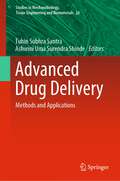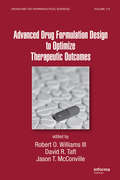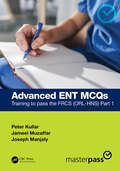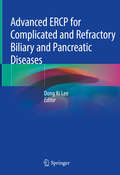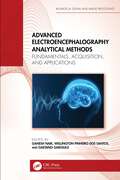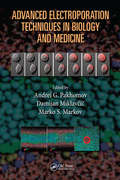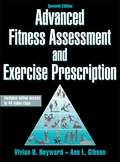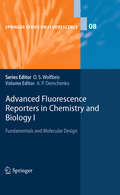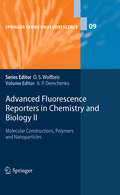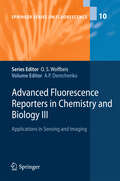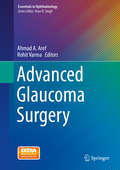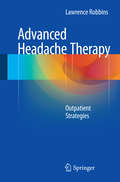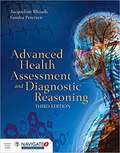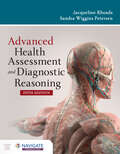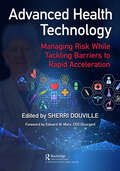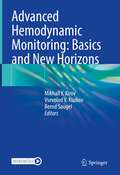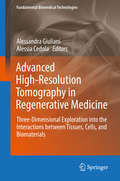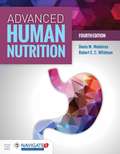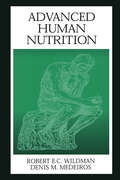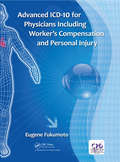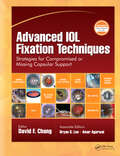- Table View
- List View
Advanced Drug Delivery: Methods and Applications (Studies in Mechanobiology, Tissue Engineering and Biomaterials #26)
by Tuhin Subhra Santra Ashwini Uma Surendra ShindeThis book provides an overview of various drug delivery systems at the cellular level including biological, chemical methods, and most importantly physical methods such as photoporation, electroporation, mechanoporation, and device-based techniques (e.g., microfluidics), as well as organism-level techniques including nanomaterials, biomaterials, and transdermal. Drug delivery (DD) can be defined as the method and route by which an active pharmaceutical ingredient (API) is administered to promote its desired pharmacological effect and/or convenience and/or to reduce adverse effects. Drug delivery systems are developed to maximize drug efficacy and minimize side effects. As drug delivery technologies improve, the drug becomes safer and more comfortable for patients to use. During the last seven decades, extraordinary progress has been made in drug delivery technologies, such as systems for long-term delivery for months and years, localized delivery, and targeted delivery. The advances, however, will face the next phase considering the future technologies that we need to overcome many physicochemical barriers for new formulation development and biological unknowns for treating various diseases. Thus, various technologies are built at a single-cell level as well as an organism level. This book is useful at the university level for graduate courses or research studies and biotechnology-based companies with research and development on cell-based analysis, diagnosis, or drug screening. This book is also very useful for researchers in drug delivery technologies, which came in frontier research for the past decade.
Advanced Drug Formulation Design to Optimize Therapeutic Outcomes (Drugs and the Pharmaceutical Sciences)
by Robert O. Williams III David R. Taft Jason T. McConvilleThis title demonstrates how advanced formulation designs and delivery technologies can be used to improve drug efficacy and treatment outcomes in particular therapeutic categories or disease states. It discusses nanoparticle systems for cancer treatments, and also presents cutting edge immono-regulation agents for transplantation and the local targ
Advanced ENT MCQs: Training to pass the FRCS (ORL-HNS) Part 1 (MasterPass)
by Joseph Manjaly Peter Kullar Jameel MuzaffarProviding over 400 high quality MCQs in the style of the Part 1 FRCS (ORL-HNS) together with clear explanations of not only the correct answer but also a structured way of approaching questions, this revision guide enables exam candidates to prepare for the FRCS (ORL-HNS) Section 1 exam with confidence.The questions and answers reflect the new approach to the exam and its focus on higher order judgement and testing real world clinical decision making. Questions are presented as a common stem with five possible answers, one of which will be the most correct answer: a ‘single best answer’. The stem is carefully written, so that every word should help guide candidates to the correct answer. None of the answers will be obviously wrong or dangerous. The candidate must recognise that a ‘single best answer’ is not the same as a ‘single correct answer’. In many of the questions, all the presented answers could be considered correct, but the candidate must choose the best or most appropriate answer from those available.Written by an expert author team who have provided valuable insights and expert content to ensure the book’s authority. The content is suitable for exam candidates from the UK and for International ENT trainees preparing to sit the FRCS (ORL-HNS) exam. It is also applicable for candidates preparing for the DOHNS/MRCS ENT exam.
Advanced ENT training: A guide to passing the FRCS (ORL-HNS) examination
by Joseph Manjaly Peter KullarThe syllabus for the FRCS (ORL-HNS) is vast and sound preparation for the exams has traditionally involved assimilatiing knowledge from a wide range of sources. This book provides a focussed guide for exam candidates. More than a question and answer book, this book is a coaching manual. Each section features a combination of model answers, pearls of wisdom, checklists and pointers for further reading. Detailed advice is provided for both Part 1 and Part 2 of the examnation. Viva topics that have featured in the exam in recent years have been included. and have then been supplemented by invaluable editorial contributions from leaders in each of the subspecialties. Trainees frequently comment that exam preparation is an enlightening process and the knowledge gained would have served them well during their time as an ENT registrar or Otorhinolaryngology resident.This book will also serve as a valuable learning tool for trainees as early as ST3 and facilitate their development of effective and safe clinical practice.
Advanced ERCP for Complicated and Refractory Biliary and Pancreatic Diseases
by Dong Ki LeeThis book provides a comprehensive overview of non-surgical treatments for complicated and refractory biliary and pancreatic lesions. In particular, it offers non-surgical treatment options for benign biliary strictures. For those suffering from intractable total biliary obstruction following biliary operation, magnetic compression anastomosis represents a good therapeutic option, and this technique is fully explained. Moreover, the book describes diverse treatment modalities for hilar stricture, which is one of the most challenging areas of ERCP. Several chapters cover a variety of important aspects of this area. The book also aims to identify and solve the unmet needs for the diagnosis and treatment of biliary and pancreatic diseases. The precise explanations of treatment concepts and strategies will both increase readers’ knowledge and provide assistance in daily clinical practice. The authors are pioneering experts from around the world, and the text is supported by numerous informative illustrations and helpful summaries.
Advanced Electroencephalography Analytical Methods: Fundamentals, Acquisition, and Applications (Biomedical Signal and Image Processing)
by Ganesh Naik Santos, Wellington Pinheiro dos Gaetano GargiuloAdvanced Electroencephalography Analytical Methods: Fundamentals, Acquisition, and Applications presents the theoretical basis and applications of electroencephalography (EEG) signals in neuroscience, involving signal analysis, processing, signal acquisition, representation, and applications of EEG signal analysis using non-linear approaches and machine learning. It explains principles of neurophysiology, linear signal processing, computational intelligence, and the nature of signals including machine learning. Applications involve computer-aided diagnosis, brain-computer interfaces, rehabilitation engineering, and applied neuroscience.This book: Includes a comprehensive review on biomedical signals nature and acquisition aspects. Focuses on selected applications of neuroscience/cardiovascular/muscle-related biomedical areas. Provides a machine learning update to a classical biomedical signal processing approach. Explains deep learning and application to biomedical signal processing and analysis. Explores relevant biomedical engineering and neuroscience state-of-the-art applications. This book is intended for researchers and graduate students in biomedical signal processing, electrical engineering, neuroscience, and computer science.
Advanced Electroporation Techniques in Biology and Medicine (Biological Effects of Electromagnetics)
by Marko S. Markov Andrei G. Pakhomov Damijan MiklavcicA reflection of the intense study of the effects of electromagnetic fields on living tissues that has taken place during the last decades, Advanced Electroporation Techniques in Biology and Medicine summarizes most recent experimental findings and theories related to permeabilization of biomembranes by pulsed electric fields. Edited by experts and
Advanced First Aid CPR + AED
by National Safety Council National Safety Council NscPart of a series of titles authored by the National Safety Council, First Aid: Taking Action covers the material required for a semester long Advanced First Aid course . The focus is teaching how to recognize and act in any emergency and to sustain life until professional help can arrive. Other information includes bleeding control, and first aid for sudden illnesses and injuries. Information is presented in a concise easy-to-read manner that works as a handy reference after the course. National Safety Council programs and products are designed to benefit all types of learning styles by combining lectures, video presentations, group discussions, and hands-on training.
Advanced Fitness Assessment and Exercise Prescription
by Ann L. Gibson Vivian H. HeywardThe text bridges the gap between research and practice and synthesizes concepts and theories from exercise physiology, kinesiology, measurement, psychology, and nutrition to provide a clearly defined approach to physical fitness testing and the design of individualized exercise programs.
Advanced Fluorescence Reporters in Chemistry and Biology I: Fundamentals and Molecular Design (Springer Series on Fluorescence #8)
by Alexander P. DemchenkoThis volume is focused on one of the most important challenges in sensing and imaging technologies: the design of fluorescence reporters with advanced properties. Here organic dyes occupy leading positions, in tough competition with novel materials such as metal chelating complexes and semiconductor nanoparticles. 11 chapters written by top experts in the field show new possibilities in the design of organic dyes as fluorescent labels and reporters. They particularly highlight the progress that has been made in enhancing the response to intermolecular interactions and their excited-state reaction dynamics (intramolecular charge and proton transfers), and on the development of dyes with strong two-photon absorption and emitting in the near-IR region. Furthermore, fluorophores incorporated into new members of the green fluorescent protein family, an invaluable tool for live cell imaging, are examined.
Advanced Fluorescence Reporters in Chemistry and Biology II: Molecular Constructions, Polymers and Nanoparticles (Springer Series on Fluorescence #9)
by Alexander P. DemchenkoThis volume demonstrates the novel possibilities in sensing and imaging offered by the assembly of organic dyes into nanoparticles and nanocomposites and by the application of strongly fluorescent noble metal clusters and conjugated polymers. Its 14 chapters, written by top experts in this field, provide in-depth information on the coupling of organic dyes to different molecular and supramolecular structures, on their incorporation into polymeric nanoparticles and on the nanostructures that can be formed by some of the dyes. Bright and photostable several-atom clusters of gold and silver are examined. Finally, the revolutionary changes in sensing technologies attending the advent of conjugated polmyers and the advances in their application are discussed.
Advanced Fluorescence Reporters in Chemistry and Biology III: Applications in Sensing and Imaging (Springer Series on Fluorescence #10)
by Alexander P. DemchenkoThe key element of any fluorescence sensing or imaging technology is the fluorescence reporter, which transforms the information on molecular interactions and dynamics into measurable signals of fluorescence emission. This book, written by a team of frontline researchers, demonstrates the broad field of applications of fluorescence reporters, starting from nanoscopic properties of materials, such as self-assembled thin films, polymers and ionic liquids, through biological macromolecules and further to living cell, tissue and body imaging. Basic information on obtaining and interpreting experimental data is presented and recent progress in these practically important areas is highlighted. The book is addressed to a broad interdisciplinary audience.
Advanced Functional Materials for Optical and Hazardous Sensing: Synthesis and Applications (Progress in Optical Science and Photonics #27)
by Rakesh Kumar Sonker Kedar Singh Rajendra SonkawadeThis book highlights the significance and usefulness of nanomaterials for the development of sensing devices and their real-life applications. The book also addresses various means of synthesizing functional materials, e.g., hydrothermal deposition process, electrospinning, Ostwald ripening, sputtering heterogeneous deposition, liquid-phase preparation, the vapor deposition approach, and aerosol flame synthesis. It presents an informative overview of the role of functional materials in the development of advanced sensor devices at the nanoscale and discusses the applications of functional materials in different forms prepared by diverse techniques in the field of optoelectronics and biomedical devices. Major features, such as type of advanced functional, fabrication methods, applications, tasks, benefits and restrictions, and saleable features, are presented in this book. Advanced functional materials for sensing have much wider applications and have an enormous impact on our environment.
Advanced Functional Materials: Proceedings Of Chinese Materials Conference 2017 (Materials Science Forum Vol. 815 Ser.)
by Yafang HanThis proceedings volume gathers selected papers presented at the Chinese Materials Conference 2017 (CMC2017), held in Yinchuan City, Ningxia, China, on July 06-12, 2017.
Advanced Glaucoma Surgery (Essentials in Ophthalmology)
by Ahmad A. Aref Rohit VarmaThis text provides expert instruction on the techniques currently employed for the surgical treatment of glaucomatous disease, covering both the host of novel microinvasive devices for treatment of milder stages and the refined strategies that enhance success rates in patients with advanced disease. The critical steps in each procedure are clearly described with the aid of many high-quality illustrations and surgical videos. Pearls and pitfalls of the various techniques are highlighted, and helpful information is provided on indications, preoperative considerations, potential intra- and postoperative complications, and strategies for reducing the incidence of such adverse events. Each treatment method is addressed in a dedicated stand-alone chapter, ensuring ease of reference for the practitioner. Readers will find this book, written by internationally recognized experts in the field, to be an exceptional source of up-to-date information on advanced glaucoma surgical techniques.
Advanced Headache Therapy: Outpatient Strategies
by Lawrence RobbinsThis cutting-edge book will cover various aspects of headache management, with a focus on difficult patients. Practical, step-by-step advice for treating challenging headaches, including migraine, refractory and cluster headaches, will be provided in detail along with how to approach patients of different ages and those with psychological disorders. Unique and complex case studies and complete explanations to the vast array of medications will also be featured. Authored by one of the leading experts on refractory headaches, Advanced Headache Management will be an invaluable guide for the resident or clinician and an easy-to-read resource for many patients.
Advanced Health Assessment and Diagnostic Reasoning
by Jacqueline Rhoads Sandra Wiggins PetersenAdvanced Health Assessment and Diagnostic Reasoning, Third Edition covers the diagnostic reasoning process that providers must follow when assessing an actual case. The text outlines each step of the health assessment process and further demonstrates the link between health history and physical examination. It also provides the healthcare professional with the essential data needed to formulate a diagnosis and treatment plan. <p><p>New Online Course! Advanced Health Assessment and Diagnostic Reasoning, Third Edition features Navigate Premier Access, a robust online course complete with interactive lectures, eBook with health assessment videos and audio clips, syllabus, instructor resource guide, image bank, practice activities, discussion questions, and testing items. Key Features: • Outlines the health assessment and diagnostic reasoning process for a nurse practitioner assessing a new patient • Provides the essential data needed to formulate a diagnosis and treatment plan • Covers the anatomy and physiology of each system • Includes coverage of specific populations (pediatric, pregnancy, geriatric) • Navigate 2 Premier Access
Advanced Health Assessment and Diagnostic Reasoning
by Jacqueline Rhoads Sandra Wiggins PetersenAdvanced Health Assessment and Diagnostic Reasoning continues to deliver a comprehensive overview of general strategies for health history taking, physical examination, and documentation in an updated Fifth Edition. It expertly covers the diagnostic reasoning process that providers must follow when assessing an actual case. The Fifth Edition outlines each step of the health assessment process and further demonstrates the link between health history and physical examination. It also provides the healthcare professional with the essential data needed to formulate a diagnosis and treatment plan.
Advanced Health Technology: Managing Risk While Tackling Barriers to Rapid Acceleration
by Sherri DouvilleEverything worth winning in life boils down to teamwork and leadership. In my positions as a businessman, athlete, community leader, and University trustee, there are tremendous parallels between all of these endeavors that mirror an extreme team sport such as medical technology. Understanding the game, defining the game, playing your position at your highest performance, and helping others play their best game. Advanced Health Technology represents an incredible opportunity to level up the game of healthcare and highlights the multiple disciplines – or positions to be mastered – while laying out winning plays to make that next level happen. Ronnie Lott, Managing Member, Lott Investments; Member, Pro Football Hall of Fame, and Trustee, Santa Clara University Healthcare stakeholders are paralyzed from making progress as risks explode in volume and complexity. This book will help readers understand how to manage and transcend risks to drive the quadruple aim of improved patient experiences, better patient and business outcomes, improved clinician experience, and lower healthcare costs, and also help readers learn from working successful examples across projects, programs, and careers to get ahead of these multidisciplinary healthcare risks.
Advanced Hemodynamic Monitoring: Basics and New Horizons
by Mikhail Y. Kirov Vsevolod V. Kuzkov Bernd SaugelThis book describes how to monitor and optimize cardiovascular dynamics using advanced hemodynamic monitoring in perioperative and intensive care medicine. The book outlines basic skills of hemodynamic monitoring, different techniques including invasive, minimally invasive, and non-invasive methods, and algorithms and treatment strategies for perioperative goal-directed hemodynamic therapy in different groups of surgical patients. Thus, the book reflects current diagnostic and therapeutic approaches in perioperative and intensive care medicine. All sections of this book have a learning-oriented style and are illustrated with tables and figures summarizing the main content. The volume is addressed both to specialists and residents using advanced hemodynamic monitoring; it reflects indications and limitations of current monitoring tools and discuss therapeutic strategies. It also helps readers to integrate new knowledge on monitoring of cardiovascular dynamics into clinical practice.
Advanced High-Resolution Tomography in Regenerative Medicine: Three-Dimensional Exploration into the Interactions between Tissues, Cells, and Biomaterials (Fundamental Biomedical Technologies)
by Alessandra Giuliani Alessia CedolaThis book covers the state-of-the-art research on advanced high-resolution tomography, exploring its role in regenerative medicine. and also explores the 3D interactions between tissues, cells, and biomaterials. Various multidisciplinary paths in regenerative medicine are covered, including X-ray microtomography and its role in regenerative medicine, synchrotron radiation-based microtomography and phase contrast tomography, the challenge of the vascularization of regenerated tissues, lung and cartilage imaging, and more. This is an ideal book for biomedical engineers, biologists, physicists, clinicians, and students who want to pursue their studies in the field of regenerative medicine.This book also:Reviews in detail the algorithms and software used for the 3D exploration of regenerated tissueCovers the latest research on the use of X-ray microtomography for muscle diseasesDetails applications of synchrotron radiation tomography in orthopedics and dentistry
Advanced Human Nutrition
by Robert E.C. Wildman Denis M. MedeirosWritten for the upper-level undergrad or graduate level majors course, Advanced Human Nutrition, Fourth Edition provides an in-depth overview of the human body and details why nutrients are important from a biochemical, physiological, and molecular perspective. Through it's writing style and clear figures and illustrations, the text clearly outlines metabolism and the molecular functions of nutrients. A variety of pedagogical elements within the text, such as “Here’s Where You Have Been” and “Here’s Where You Are Going,” help clarify key points from the chapter and provide real-world examples to bring the content to life. <P><P>New & Key to the Fourth Edition - NEW - Each chapter now concludes with "Clinical Insight" which presents the clinical relevance of the nutritional science topics covered within the chapter - NEW - Chapter 2 now discusses bariatric surgery procedures used to treat obesity, as well as diseases of the gastrointestinal track that have nutritional relevance in health and disease - NEW - Includes the latest algorithms used by the American Heart Association and American College of Cardiology in determining the risk of a cardiac event - NEW - Incorporates controversy brought about by some scientists on protein requirements as it relates to the RDA - NEW - Includes coverage of the role of the fat-soluable vitamins in Alzheimer's disease.
Advanced Human Nutrition (Modern Nutrition)
by Robert E.C. Wildman Denis M. MedeirosThis text begins with an in-depth overview into the human organism at the molecular, cellular, tissue and organ levels, and develops into a discussion of the objectives and features of organ systems of the evolved human. The book also covers the relationship between the human body and the environment in which it exists including other organisms tha
Advanced ICD-10 for Physicians Including Worker’s Compensation and Personal Injury
by Eugene FukumotoICD-10 is the 10th revision of the International Statistical Classification of Diseases and Related Health Problems (ICD), a medical classification list by the World Health Organization. It contains codes for diseases, signs and symptoms, abnormal findings, complaints, social circumstances, and external causes of injury of diseases. The code set allows more than 14,000 different codes and permits the tracking of many new diagnoses. The U.S. has used ICD-10-CM (Clinical Modification) since October, 2015. This national variant of ICD-10 was provided by the Centers for Medicare and Medicaid Services (CMS) and the National Center for Health Statistics, and the use of ICD-10-CM codes are now mandated for all inpatient medical reporting requirements. This book is for physicians, practice managers and all others who need learn ICD-10. It’s designed for the clinician to learn how to put their diagnosis into a code and not rely on staff or computer software programs to decide it form them. ICD-10 is a complex system of coding and Medicare and third party insurers have been lenient giving providers a year to get used to the coding system. As a result, physicians and their staff have become very complacent regarding proper coding. However, Medicare and third party insurers will soon begin to deny claims which are not coded correctly, which in turn will cost physician groups time and money. This book focuses on Worker’s Compensation and Personal Injury, a very large segment of the healthcare industry and is a new area to ICD-10. The diagnosis coding for injuries is much different than for Medicare or group insurance and unless the physicians and their staff learn how to use it properly, they risk losing income for themselves and worse, they risk losing the case for the patient.
Advanced IOL Fixation Techniques: Strategies for Compromised or Missing Capsular Support
by David F. ChangAbnormal or deficient capsular anatomy creates numerous surgical challenges and predisposes eyes to IOL complications. Literally dozens of different approaches have been devised to implant IOLs in the face of compromised capsular support. However, a comprehensive compendium of the most important surgical strategies has not existed, until now.Advanced IOL Fixation Techniques:Strategies for Compromised or Missing Capsular Support provides this much-needed resource with more than 70 different chapters that cover the wide array of surgical approaches. Among the contributors are many of the original innovators of the most important technologies and methodologies. In addition to teaching a specific surgical technique, these authors cover its history, rationale, and clinical results. Editor Dr. David F. Chang is well known and acclaimed for 2 best-selling cataract textbooks—Mastering Refractive IOLs and Phaco Chop and Advanced Phaco Techniques. Along with associate editors Drs. Bryan S. Lee and Amar Agarwal, Dr. Chang has now tackled this new major subject area—how to best fixate IOLs when capsular support is compromised or absent. Part One covers capsular fixation with either zonulopathy or following posterior capsule rupture. Topics include using conventional and modified capsular tension rings, capsular tension segments or capsular anchors, standard and reverse optic capture with anterior capsulorrhexis, sulcus fixation, posterior capsulorrhexis, and capsular membrane suture fixation. Part Two covers noncapsular fixation. Topics include anterior chamber IOLs, iris claw IOLs, iris and transscleral suture fixation of posterior chamber IOLs, and intrascleral haptic fixation using the Yamane double-needle or glued IOL methods. Part Three covers miscellaneous topics such as anterior vitrectomy, IOL power calculation for noncapsular IOLs, and sliding slip knots and suture pupilloplasty. To facilitate skills transfer, most chapters present detailed, step-by-step descriptions of the different techniques. The maneuvers are illustrated by over 1,100 diagrams and high-resolution surgical images. Finally, nearly every chapter is accompanied by narrated instructional videos. Combining over 150 videos, schematic diagrams, surgical images, and detailed written descriptions, Advanced IOL Fixation Techniques provides the most effective way to learn advanced surgical techniques. With its comprehensive and practical approach to covering the gamut of strategies and devices, Advanced IOL Fixation Techniques:Strategies for Compromised or Missing Capsular Support will be an indispensable resource for cataract surgeons at all levels of experience.
